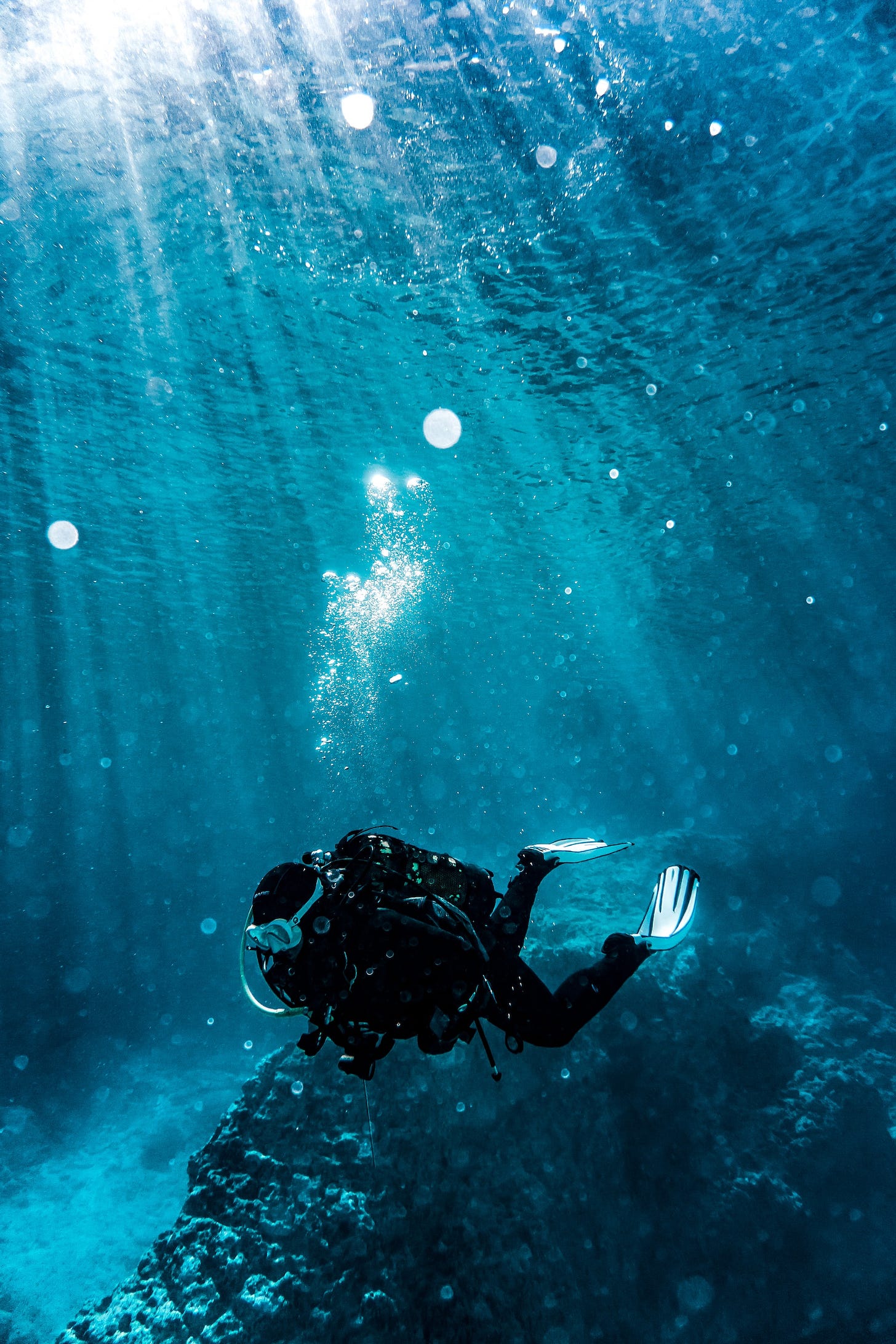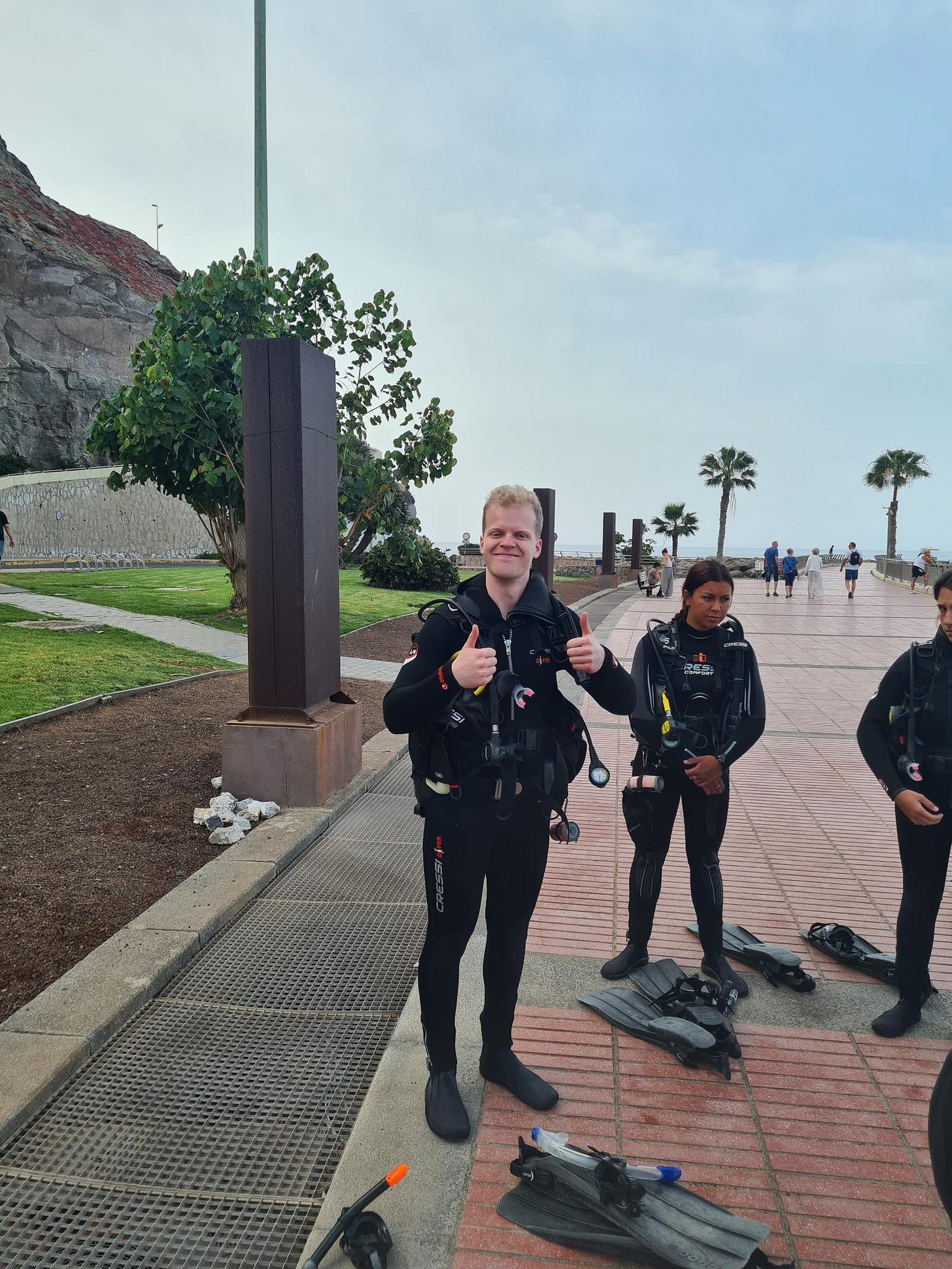In the cold winter months, Mike and his colleagues were talking about doing a weeklong workation for the first time. His colleagues did not need a lot of convincing, and within a few minutes, the planning had already started. Soon, an additional idea emerged: “What if we don’t only go there to work, but we also go scuba diving?” The holiday kept getting better and better. Since 3 out of 4 people (including Mike), weren’t officially certified to scuba dive - and had never done it in the first place - it meant we had to get certified first. Once that was out of the way, we could do some dives together.
In the following blog post, I will tell you a bit more about why we chose to go to Gran Canaria for 7 nights, our overall stay there, and most importantly, my experience of learning how to dive in Gran Canaria!
Why Gran Canaria?
The choice to go to Gran Canaria was because of a few factors:
It had to be in Europe since we would also be working from there, and this would avoid a lot of hassle
We would be traveling in April, meaning most parts of Europe aren’t warm yet. Next to diving, we also wanted to enjoy our pool for a bit
Flights and accommodation had to be reasonably priced
This leads us to the Canary Islands, which also includes Tenerife, La Palma, Lanzarote, and more. We chose to go to Gran Canaria because of the water temperature (22 degrees all year round), and the relative calmness of the water, and since one of my colleagues had already done some diving in Tenerife, we opted for a new destination.
Getting there
In April 2023, one of the only good options to get to Gran Canaria is to travel with Vueling. Now, Vueling itself isn’t the worst airline, but if I can avoid traveling with Vueling, I’ll try. For this trip, it either meant traveling with Vueling non-stop, or adding 1 stop with another carrier and adding 3 hours to the travel time. Vueling it is then.
The flight departed Schiphol at 7:20 AM, and after flying for 4 hours and 45 minutes (yes that is also longer than I expected..) we arrived in sunny Las Palmas, Gran Canaria.
After a bus ride of approximately 45 minutes and a walk of 20 minutes, we arrived at our accommodation for the week, Tauro Serenity on the southwestern part of the island. The accommodation had 3 bedrooms, a nice outside area with a private pool, and the nearest supermarket was a 2-minute walk, what else do you need?
Becoming PADI Certified
When you want to become certified in scuba diving, you generally have a few options for certification organizations. The most popular and most widely recognized organization is PADI (Professional Association of Diving Instructors), which is also the one we chose. Gran Canaria has multiple PADI-certified Dive Shops where you can get your certification and we went for Blue Water Diving. To be honest, it's probably fine to do it at any PADI Certified Dive Shop, we just chose this one because it had the best reviews and was close to our accommodation.
The first scuba diving certification level at PADI is the Open Water Diver. After completing this course, you can dive to depths of approximately 20 meters anywhere in the world. The course generally takes 3 days and consists of an e-learning part, 5 dives in a pool environment or shallow waters, and 4 open-water dives. In our case, the course only took 2 days, since we already completed the e-learning before leaving for Gran Canaria. If you have the time, I would highly suggest finishing this before starting the dives, not only will you feel more comfortable knowing all the rules and fundamentals, but it will also save you a day, or some evening studying while you are on holiday. There are better ways to spend your time on holiday!
We started the course the day after we arrived, on a Wednesday at 9 AM, the first day consisted of getting our scuba gear ready and getting to know the basics of diving. This includes getting used to breathing underwater, controlling your buoyancy (which is the way you control your vertical movement underwater), and learning the hand signals. My least favorite component of the course was learning how to flood your mask with water and then having to clear it (make the water go away whilst still underwater). Even though I’m happy that I know how to do it in the unexpected case that it’s necessary during a dive, I hated doing it and I really hope I never have to do it again!
After finishing the first day, and experiencing for the first time how exhausting diving is, we were all ready for the second and final day which included the following exercises: fully removing your mask and swimming a short distance (not again.. ugh), some basic navigation skills, safety stops, and controlled emergency swimming ascents in case of an air supply failure, removing parts of your scuba gear and putting it back on, and more. All three of us completed the fourth open-water dive successfully and we were now all PADI Open Water Certified!
The whole certification cost us 455 euros per person. It's not cheap, but diving isn’t known to be a cheap sport. Although it's a bit expensive, becoming PADI certified opens up a new world of possibilities (literally). Now I’m able to dive almost anywhere on our planet, and I’d say that’s worth it.
My First Real Dive
We planned to have a rest day on Friday and dive on Saturday and Sunday. Monday would be another rest day since PADI recommends to not dive 24 hours before flying (read their blog post about here). We only found out on Friday, however, that the dive shop would be closed on Saturday. This meant, that our diving options were, unfortunately, limited to the Sunday. Nonetheless, you usually make two dives in one day, so we arrived at the dive shop at 9 AM on Sunday, all set for a fun day below the surface.
During our certification process, our instruction sessions would take place along the shoreline. This involved either walking into the water or stepping in from a small platform. The dynamics shift, however, when it comes to going on actual dives. This usually entails a short boat journey to the diving spot where you enter the water from the boat itself—we’re leveling up! Our boat ride to our inaugural dive site took us approximately 25 minutes. After that, it was time to get into the ocean. The descent into the depths was an amazing experience, this was the first time I was able to enjoy the views without thinking of safety drills all the time. This particular moment will stay in my memory; it's as if an entirely new world unveiled itself before me.
The dive location was centered around a sunken wreck, full of marine life. Among the sea life we encountered were multiple trumpet fish, a barracuda, and the skeletal remains of a tuna. The skeletal remains were a bit of a mystery to me until I surfaced and had the chance to clarify what I saw. Picture this: I was diving without contacts, so my vision underwater was a bit unsharp. The other divers signaled the tuna sign (our agreed-upon gesture was the act of opening a can), while I struggled to see mere white specks across the ocean floor. My mind was thinking ‘Perhaps the result of their romantic adventures?’. My attempt to signal my thoughts to my buddy diver resulted in a confused response (understandably so). Hence, upon resurfacing and asking about the white tuna substance on the ocean floor, the puzzle pieces began to fall into pieces as I learned they were, in fact, bones.

Unfortunately, my buddy and I went through our oxygen tanks a bit faster than my other two colleagues, which meant we had to surface earlier with one of the dive instructors. My other two colleagues stayed under for an additional 5 minutes, and in those 5 minutes, a yellow submarine (cue the Beatles song) passed by hosting an underwater tour for tourists. You can imagine how bummed I was that I missed such a unique sight.

Chasing a Mystical Sea Creature
When we got back on the boat, we had to take off our scuba gear, rest for 30 minutes, and then prepare to dive again by putting everything back on and entering the water. Whilst we were waiting and resting, the ocean was making the boat rock quite heavily, which made several of us (including me) a bit nauseous. Luckily, after drinking some water and eating a quick snack, it was already time to prepare for the second dive of the day.
This dive would be a dive where we would descend, swim along a rock formation, and ascent at a different spot. After getting back into the water, signaling the “all-ok”, and going down, there was not much to see, unfortunately. In comparison to the previous dive, there wasn’t much sea life to explore even though we swam to various places. Luckily, however, when our air was close to the level where we would prepare for our ascent again, we spotted an eagle ray. This was for sure a highlight of the day. The creature just seemed to fly through the water with its flowing strokes. We tried to keep up as long as possible, but after a good minute, we had to stop and start resurfacing again.
When the boat picked us up again, we had so much fun recounting the things we saw (or didn’t see in some cases 😉) and sharing our experiences. Back on shore, we cleaned our equipment, said our thanks, bid farewell to the diving crew, and headed off for a well-deserved lunch.

For the people who want to read some stats about the dives:
First Dive:
Max depth: 19.5 meters
Duration: 33 minutes
Visibility: 15 meters
Bottom temperature: 20 degrees
Second Dive:
Max depth: 18.9 meters
Duration: 35 minutes
Visibility: 15 meters
Bottom temperature: 20 degrees
What's next for me?
Now that I’ve learned to scuba dive, I want to do this as much as possible. It's a lot of fun and there are endless opportunities to explore the ocean and its wildlife. With this in mind, the same colleagues and I went diving in the Vinkeveense Plassen here in The Netherlands. A few friends of one of my colleagues also joined who were already experienced divers. Unfortunately for all of us, we hit the unlucky jackpot and were hit with the worst visibility everyone had experienced in the Vinkeveense Plassen. At some points, visibility was down to 50 centimeters. Despite this, we had a great time, but I can tell you that diving in Gran Canaria was definitely more exciting!
In terms of future dives, I’ll be heading off on my first solo trip in November and I’ll get up to some diving there (my solo travel location will be revealed in an upcoming post, so stay tuned for that). Hopefully, 2024 will bring even more opportunities to explore marine life. Perhaps I can even convince Hannah to get certified so we can explore this exciting part of the world together! Fingers crossed 🙂
Have you ever gone scuba-diving? If so, what are your favorite places to do so? Or have I inspired you to try it out for the first time? Let me know in the comments below, and I’ll be back with more diving stories ASAP!





The underwater world is honestly so magical and mystical 🥹 I'm curious though, was it a personal choice to dive without contacts or is it somehow impossible/not allowed?